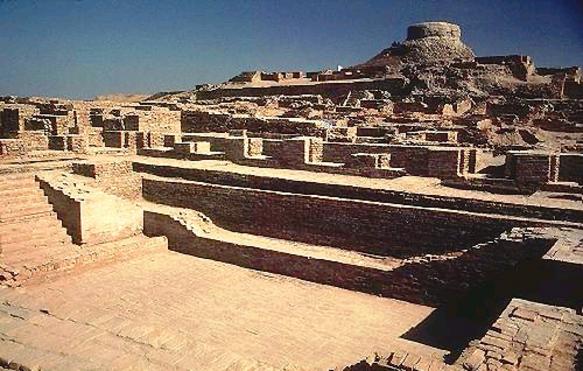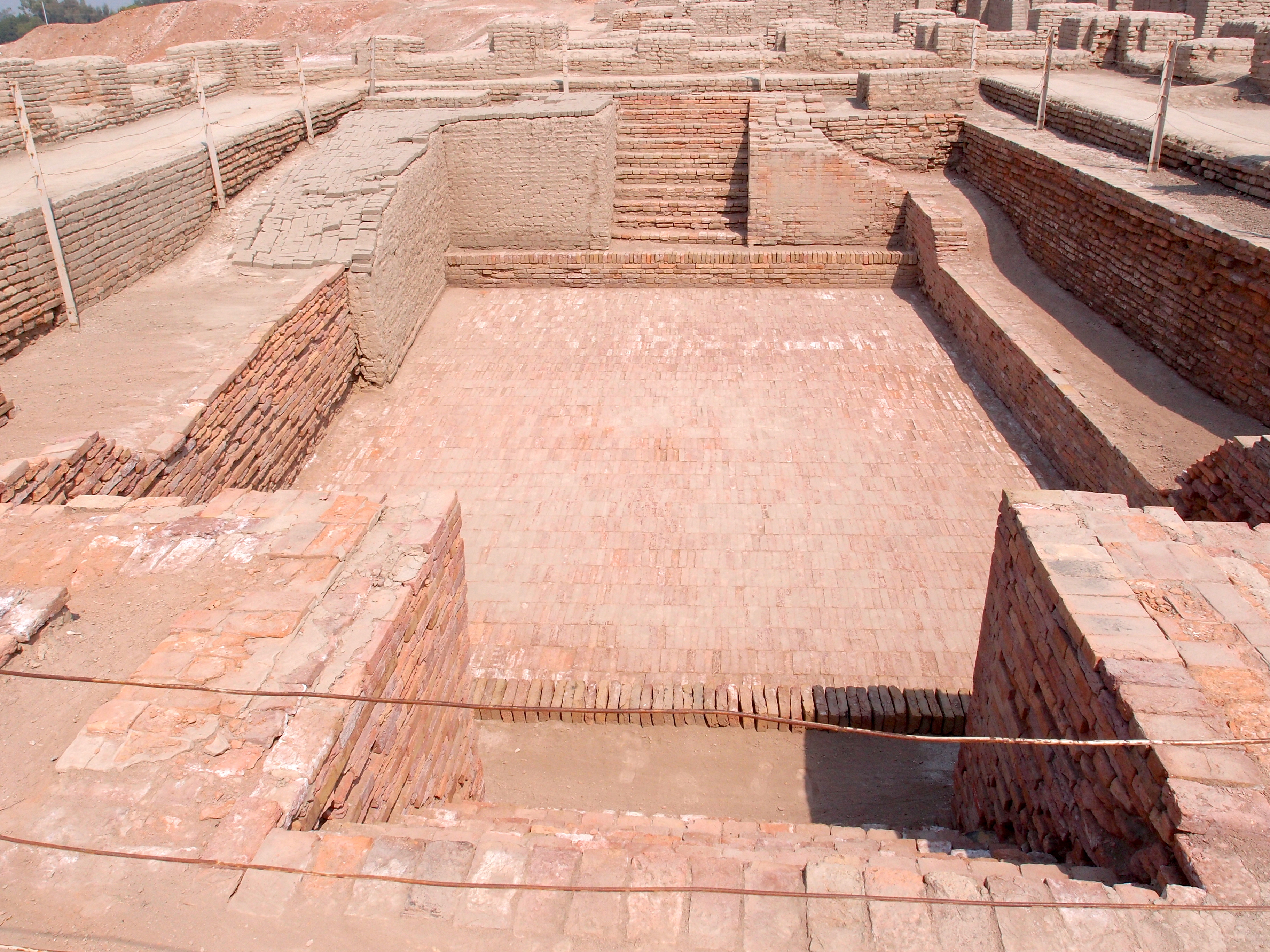Sanitation in the Indus Valley Civilization on:
[Wikipedia]
[Google]
[Amazon]


 The ancient
The ancient






Indus Valley Civilization
The Indus Valley Civilisation (IVC), also known as the Indus Civilisation was a Bronze Age civilisation in the northwestern regions of South Asia, lasting from 3300 BCE to 1300 BCE, and in its mature form 2600 BCE to 1900& ...
in South Asia
South Asia is the southern subregion of Asia, which is defined in both geographical and ethno-cultural terms. The region consists of the countries of Afghanistan, Bangladesh, Bhutan, India, Maldives, Nepal, Pakistan, and Sri Lanka.;;;;;;; ...
, including current day's Pakistan
Pakistan ( ur, ), officially the Islamic Republic of Pakistan ( ur, , label=none), is a country in South Asia. It is the world's fifth-most populous country, with a population of almost 243 million people, and has the world's second-lar ...
and north India
India, officially the Republic of India (Hindi: ), is a country in South Asia. It is the seventh-largest country by area, the second-most populous country, and the most populous democracy in the world. Bounded by the Indian Ocean on the so ...
, was prominent in infrastructure, hydraulic engineering
Hydraulic engineering as a sub-discipline of civil engineering is concerned with the flow and conveyance of fluids, principally water and sewage. One feature of these systems is the extensive use of gravity as the motive force to cause the mov ...
, and had many water supply
Water supply is the provision of water by public utilities, commercial organisations, community endeavors or by individuals, usually via a system of pumps and pipes. Public water supply systems are crucial to properly functioning societies. Thes ...
and sanitation
Sanitation refers to public health conditions related to clean drinking water and treatment and disposal of human excreta and sewage. Preventing human contact with feces is part of sanitation, as is hand washing with soap. Sanitation systems ...
devices that are the first known examples of their kind.
General
Most houses of Indus Valley were made from mud, dried mud bricks, or clay bricks. The urban areas of the Indus Valley civilization included public and private baths. Sewage was disposed of through underground drains built with precisely laid bricks, and a sophisticated water management system with numerous reservoirs was established. In the drainage systems, drains from houses were connected to wider public drains. Many of the buildings at Mohenjo-Daro had two or more stories. Water from bathrooms on the roofs and upper stories was carried through enclosed terracotta pipes or open chutes that emptied onto the street drains. The earliest evidence of urban sanitation was seen inHarappa
Harappa (; Urdu/ pnb, ) is an archaeological site in Punjab, Pakistan, about west of Sahiwal. The Bronze Age Harappan civilisation, now more often called the Indus Valley Civilisation, is named after the site, which takes its name from a mode ...
, Mohenjo-daro
Mohenjo-daro (; sd, موئن جو دڙو'', ''meaning 'Mound of the Dead Men';Rakhigarhi
Rakhigarhi or Rakhi Garhi is a village and an archaeological site belonging to the Indus Valley civilisation in Hisar District of the northern Indian state of Haryana, situated about 150 km northwest of Delhi. It was part of the mature ph ...
. This urban plan included the world's first urban sanitation systems. Within the city, individual homes or groups of homes obtained water from wells. From a room that appears to have been set aside for bathing, wastewater was directed to covered drains, which lined the major streets.
Devices such as shadoof
A shadoof or shaduf (from the Arabic word , ''šādūf'') is an irrigation tool. It is highly efficient, and has been known since 3000 BCE.
Names
It is also called a lift, well pole, well sweep, or simply a sweep in the US.Knight, Edward Henry ...
s and sakia
A sāqiyah or saqiya ( ar, ساقية), also spelled sakia or saqia) is a mechanical water lifting device. It is also called a Persian wheel, tablia, rehat, and in Latin tympanum. It is similar in function to a scoop wheel, which uses buckets, ...
s were used to lift water to ground level. Ruins like Mohenjo-Daro in Pakistan and Dholavira
Dholavira ( gu, ધોળાવીરા) is an archaeological site at Khadirbet in Bhachau Taluka of Kutch District, in the state of Gujarat in western India, which has taken its name from a modern-day village south of it. This village is ...
in Gujarat
Gujarat (, ) is a state along the western coast of India. Its coastline of about is the longest in the country, most of which lies on the Kathiawar peninsula. Gujarat is the fifth-largest Indian state by area, covering some ; and the ninth- ...
in India had settlements with some of the ancient world's most sophisticated sewage systems. They included drainage channels, rainwater harvesting, and street ducts.
Stepwell
Stepwells (also known as vavs or baori) are wells or ponds with a long corridor of steps that descend to the water level. Stepwells played a significant role in defining subterranean architecture in western India from 7th to 19th century. So ...
s have mainly been used in the Indian subcontinent.
Several courtyard houses had both a washing platform and a dedicated toilet/waste disposal hole. The toilet holes would be flushed by emptying a jar of water, drawn from the house's central well, through a clay brick pipe, and into a shared brick drain, that would feed into an adjacent soak pit (cesspit
A cesspit (or cesspool or soak pit in some contexts) is a term with various meanings: it is used to describe either an underground holding tank (sealed at the bottom) or a soak pit (not sealed at the bottom). It can be used for the temporary co ...
). The soak pits would be periodically emptied of their solid matter, possibly to be used as fertilizer. Most houses also had private wells
Wells most commonly refers to:
* Wells, Somerset, a cathedral city in Somerset, England
* Well, an excavation or structure created in the ground
* Wells (name)
Wells may also refer to:
Places Canada
* Wells, British Columbia
England
* Wel ...
. City walls
A defensive wall is a fortification usually used to protect a city, town or other settlement from potential aggressors. The walls can range from simple palisades or earthworks to extensive military fortifications with towers, bastions and gates ...
functioned as a barrier against flood
A flood is an overflow of water ( or rarely other fluids) that submerges land that is usually dry. In the sense of "flowing water", the word may also be applied to the inflow of the tide. Floods are an area of study of the discipline hydrolog ...
s.
Mohenjo-daro
Mohenjo-daro
Mohenjo-daro (; sd, موئن جو دڙو'', ''meaning 'Mound of the Dead Men';Sindh
Sindh (; ; ur, , ; historically romanized as Sind) is one of the four provinces of Pakistan. Located in the southeastern region of the country, Sindh is the third-largest province of Pakistan by land area and the second-largest province ...
, Pakistan, is one of the best excavated and studied settlements from this civilization. The Great Bath
The Great Bath is one of the best-known structures among the ruins of the Harappan Civilization excavated at Mohenjo-daro in Sindh, Pakistan.
might be the first of its kind in the pre-historic period. This ancient town had more than 700 wells, and most houses in Mohenjo-Daro had at least one private well.
Dholavira
Dholavira
Dholavira ( gu, ધોળાવીરા) is an archaeological site at Khadirbet in Bhachau Taluka of Kutch District, in the state of Gujarat in western India, which has taken its name from a modern-day village south of it. This village is ...
, located in Gujarat
Gujarat (, ) is a state along the western coast of India. Its coastline of about is the longest in the country, most of which lies on the Kathiawar peninsula. Gujarat is the fifth-largest Indian state by area, covering some ; and the ninth- ...
, India
India, officially the Republic of India (Hindi: ), is a country in South Asia. It is the seventh-largest country by area, the second-most populous country, and the most populous democracy in the world. Bounded by the Indian Ocean on the so ...
(c. 3000-1500 BC), had a series of water storage tanks and step wells, and its water management system has been called "unique". Dholavira had at least five baths and the size of one is comparable with the Great Bath of Mohenjo-daro.
Lothal


Lothal
Lothal () was one of the southernmost sites of the ancient Indus Valley civilisation, located in the Bhāl region of the modern state of Gujarāt. Construction of the city is believed to have begun around 2200 BCE.
Archaeological Survey o ...
, Gujarat
Gujarat (, ) is a state along the western coast of India. Its coastline of about is the longest in the country, most of which lies on the Kathiawar peninsula. Gujarat is the fifth-largest Indian state by area, covering some ; and the ninth- ...
(c. 2350–1900 BC), excavation of the site has identified two wells in the city, one in the acropolis
An acropolis was the settlement of an upper part of an ancient Greek city, especially a citadel, and frequently a hill with precipitous sides, mainly chosen for purposes of defense. The term is typically used to refer to the Acropolis of Athens, ...
and the other by the dock. In addition, more than a dozen houses of the acropolis possessed their own internal bathing platform which drained into a covered communal sewer constructed of brickwork held together with a gypsum-based mortar and which emptied into a cesspit outside the town's wall. A relatively large house in the acropolis had a bathing platform with an attached latrine, that fed into a separate open drain, and discharged into the town's dock. The Lower town hosts a number of soak pots, large sunken jars with a hole in the bottom, to permit liquids to drain, which were regularly emptied and cleaned.
See also
*Harappa
Harappa (; Urdu/ pnb, ) is an archaeological site in Punjab, Pakistan, about west of Sahiwal. The Bronze Age Harappan civilisation, now more often called the Indus Valley Civilisation, is named after the site, which takes its name from a mode ...
* Harappan architecture
* History of water supply and sanitation
The history of water supply and sanitation is one of a logistical challenge to provide clean water and sanitation systems since the dawn of civilization. Where water resources, infrastructure or sanitation systems were insufficient, diseases spre ...
* Sanitation in ancient Rome
Sanitation in ancient Rome, acquired from the Etruscans, was well advanced compared to other ancient cities and provided water supply and sanitation services to residents of Rome. Although there were many sewers, public latrines, baths and other s ...
* List of Indus Valley Civilisation sites
Over 1400 Indus Valley civilisation sites have been discovered, of which 925 sites are in India and 475 sites in Pakistan, while some sites in Afghanistan are believed to be trading colonies. Only 40 sites on the Indus valley were discovered ...
* List of inventions and discoveries of the Indus Valley Civilisation
This list of inventions and discoveries of the Indus Valley Civilisation lists the technological and civilisational achievements of the Indus Valley Civilisation, an ancient civilisation which flourished in the Bronze Age around the general r ...
References
{{Indus Valley civilization Indus Valley civilisation History of water supply and sanitation Water supply and sanitation in India Water supply and sanitation in Pakistan Indian inventions Inventions of the Indus Valley civilisation